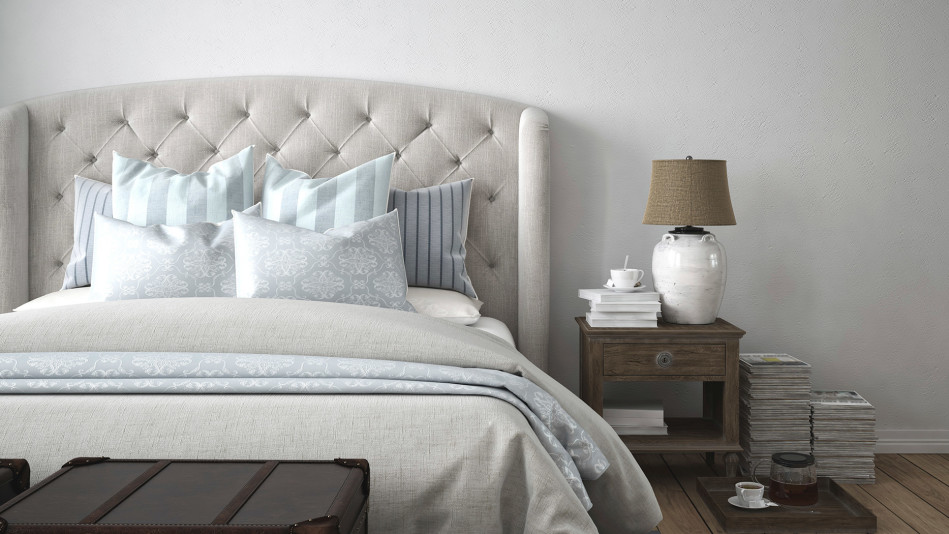Here's Everything We Know About How to Get a Good Night's Sleep
No kooky pre-bed concoctions or old wives' tales—just tried-and-true tips we've heard experts recommend time and time again.

Photo: 2Mmedia/istockphoto
The Dos and Don'ts of a Sleep-Friendly Bedroom
Do: Adopt a Two-Blanket Strategy
One for you and one for your partner. Having individual blankets is a common practice in Europe, and it eliminates any cover-hogging disputes while making you less aware of each other's movements throughout the night.
Do: Follow These Mattress Commandments
1. Pick the Right One—The ideal width is around 71 inches, according to sleep researchers, which falls somewhere between a queen size (60 inches across) and a king (76 inches across) and leaves enough space for sleepers to stay an arm's length from each other. As for firmness, studies suggest that medium-firm is comfortable for most people. If you or your partner move a lot at night or you two don't go to sleep and get up at the same time, a memory-foam model can make you feel like you're the only one in the bed.
2. Prevent the Dreaded Trench from Forming—You're probably not rotating your mattress often enough. Single-sided models (e.g., memory foam and pillow top) should be rotated from end to end every two months, meaning the foot of the mattress is now at the head, according to Consumer Reports. Double-sided mattresses should also be rotated, then flipped, with the same frequency.
Don't: Let Fido in the Bed
Pet dander can trigger nighttime allergies, and an animal's movements, purring and snoring can push you out of deep sleep and into a lighter, less restorative sleep stage. We're betting your pet probably has its own bed somewhere in the house that's going unused.
Don't: Fall into the "I'm just going to get back into bed tonight, so why spend time making it in the morning?" Mentality
A poll by the National Sleep Foundation showed that people who make their bed every day are 19 percent more likely to get a better night's rest, possibly because it keeps them from crawling in for sleep-disruptive activities like watching T.V. or answering a few more work emails before bed.
Don't: Forget the Basics
Keep your bedroom cool (between 65 and 72 degrees) and dark (lights should be dimmed at least 30 minutes before bed; layer blackout liners behind curtains to block morning rays that could wake you up) and maintain quiet (use a white-noise machine or app or a fan to drown out disruptive sounds).
Do: Adopt a Two-Blanket Strategy
One for you and one for your partner. Having individual blankets is a common practice in Europe, and it eliminates any cover-hogging disputes while making you less aware of each other's movements throughout the night.
Do: Follow These Mattress Commandments
1. Pick the Right One—The ideal width is around 71 inches, according to sleep researchers, which falls somewhere between a queen size (60 inches across) and a king (76 inches across) and leaves enough space for sleepers to stay an arm's length from each other. As for firmness, studies suggest that medium-firm is comfortable for most people. If you or your partner move a lot at night or you two don't go to sleep and get up at the same time, a memory-foam model can make you feel like you're the only one in the bed.
2. Prevent the Dreaded Trench from Forming—You're probably not rotating your mattress often enough. Single-sided models (e.g., memory foam and pillow top) should be rotated from end to end every two months, meaning the foot of the mattress is now at the head, according to Consumer Reports. Double-sided mattresses should also be rotated, then flipped, with the same frequency.
Don't: Let Fido in the Bed
Pet dander can trigger nighttime allergies, and an animal's movements, purring and snoring can push you out of deep sleep and into a lighter, less restorative sleep stage. We're betting your pet probably has its own bed somewhere in the house that's going unused.
Don't: Fall into the "I'm just going to get back into bed tonight, so why spend time making it in the morning?" Mentality
A poll by the National Sleep Foundation showed that people who make their bed every day are 19 percent more likely to get a better night's rest, possibly because it keeps them from crawling in for sleep-disruptive activities like watching T.V. or answering a few more work emails before bed.
Don't: Forget the Basics
Keep your bedroom cool (between 65 and 72 degrees) and dark (lights should be dimmed at least 30 minutes before bed; layer blackout liners behind curtains to block morning rays that could wake you up) and maintain quiet (use a white-noise machine or app or a fan to drown out disruptive sounds).

Photo: Yuri_Arcurs/istockphoto
8 Rules to Follow Before, During and After Sleep
Rule #1—Go to bed and get up at the same time every day. (You knew that was coming, right?)
Rule #2—Fall asleep 20 minutes faster by picturing yourself in a relaxing locale, according to the findings of a University of Oxford study. You can also try counting backward from 300 by threes instead of counting sheep, says Michael Breus, PhD, a clinical psychologist and the author of The Sleep Doctor's Diet Plan: Lose Weight Through Better Sleep. (Research has shown that the sheep trick is actually too simple to be effective).
Rule #3—In the 2 hours before bed, try not to drink any liquids, so you won't have to get up to pee during the night. At least 6 hours before bed, stop drinking caffeine, to prevent it from keeping you up. Three to 4 hours before bed, stop drinking alcohol—it may help you conk out fast, but you'll wake up in the second half of the night after your body is done metabolizing it.
Rule #4—Give yourself a 30-minute gadget-free period before bed—that includes smartphones, tablets, laptops and TVs (you can re-watch Making a Murderer and come up with new theories on what really happened another time). The blue light they give off can delay your body's release of melatonin. Do something relaxing with that 30-minute window instead, like making some headway on the best-seller you keep meaning to read.
Rule #5—Leave your book in the living room. You know you're not supposed to lie in bed tossing and turning, so having a good book waiting for you in another area gives you an automatic place to go and a calming activity to do when the inevitable (but hopefully infrequent) sleepless night happens. Keep the light just bright enough to read by.
Rule #6—Don't get into bed until it's actually time to go to sleep. The more time you spend out of bed, the stronger your sleep drive, or your need for deep sleep, says Colleen Carney, PhD, coauthor of the book Goodnight Mind: Turn off Your Noisy Thoughts and Get a Good Night's Sleep.
Rule #7—Assume the right position. Stomach sleeping can lead to tossing and turning because of the stress it puts on your neck, and sleeping on your back can make sleep apnea (and snoring) worse. Try curling up on your non-dominant side with a pillow between your knees instead. Doing so takes pressure off your lower back and places your body weight on the joints, muscles and tendons that you don't use as much (which means they're less sensitive), says Nick Littlehales, a U.K.-based sleep coach.
Rule #8—Seriously—stop using the snooze button. That seemingly innocent just-10-more-minutes tap (or taps plural, if you're like most of us) can lead to a must-to-go-back-to-bed feeling that can last anywhere from 2 to 4 hours after you finally get up, according to research. Continually waking up then falling back asleep confuses your brain and body, leaving you groggier and more tired than you would be if you'd just gotten up the first time the alarm went off.
Rule #1—Go to bed and get up at the same time every day. (You knew that was coming, right?)
Rule #2—Fall asleep 20 minutes faster by picturing yourself in a relaxing locale, according to the findings of a University of Oxford study. You can also try counting backward from 300 by threes instead of counting sheep, says Michael Breus, PhD, a clinical psychologist and the author of The Sleep Doctor's Diet Plan: Lose Weight Through Better Sleep. (Research has shown that the sheep trick is actually too simple to be effective).
Rule #3—In the 2 hours before bed, try not to drink any liquids, so you won't have to get up to pee during the night. At least 6 hours before bed, stop drinking caffeine, to prevent it from keeping you up. Three to 4 hours before bed, stop drinking alcohol—it may help you conk out fast, but you'll wake up in the second half of the night after your body is done metabolizing it.
Rule #4—Give yourself a 30-minute gadget-free period before bed—that includes smartphones, tablets, laptops and TVs (you can re-watch Making a Murderer and come up with new theories on what really happened another time). The blue light they give off can delay your body's release of melatonin. Do something relaxing with that 30-minute window instead, like making some headway on the best-seller you keep meaning to read.
Rule #5—Leave your book in the living room. You know you're not supposed to lie in bed tossing and turning, so having a good book waiting for you in another area gives you an automatic place to go and a calming activity to do when the inevitable (but hopefully infrequent) sleepless night happens. Keep the light just bright enough to read by.
Rule #6—Don't get into bed until it's actually time to go to sleep. The more time you spend out of bed, the stronger your sleep drive, or your need for deep sleep, says Colleen Carney, PhD, coauthor of the book Goodnight Mind: Turn off Your Noisy Thoughts and Get a Good Night's Sleep.
Rule #7—Assume the right position. Stomach sleeping can lead to tossing and turning because of the stress it puts on your neck, and sleeping on your back can make sleep apnea (and snoring) worse. Try curling up on your non-dominant side with a pillow between your knees instead. Doing so takes pressure off your lower back and places your body weight on the joints, muscles and tendons that you don't use as much (which means they're less sensitive), says Nick Littlehales, a U.K.-based sleep coach.
Rule #8—Seriously—stop using the snooze button. That seemingly innocent just-10-more-minutes tap (or taps plural, if you're like most of us) can lead to a must-to-go-back-to-bed feeling that can last anywhere from 2 to 4 hours after you finally get up, according to research. Continually waking up then falling back asleep confuses your brain and body, leaving you groggier and more tired than you would be if you'd just gotten up the first time the alarm went off.

Photo: knape/istockphoto
2 Things to Get When You're Not in Bed
1. Bright light, of the natural or man-made variety. Getting light in the morning works to sync your internal clock with nature's light-dark cycle, which helps your body release sleep-inducing melatonin at the right time. Sunshine is ideal, but if your schedule or location makes that unrealistic, consider getting a light box instead (experts recommend one with more than 10,000 lux—just keep it at least 18 inches away from your eyes).
2. Regular exercise. It can improve sleep quality by up to 65 percent. Research from Oregon State University found that getting 150 minutes of moderate to vigorous exercise per week made that big of a difference. Don't worry if the only time you can fit it in is at night—the idea that p.m. exercise derails sleep has been debunked. The one exception: very vigorous exercise very close to bedtime (so save the HIIT routines for days when you can work out a little earlier).
1. Bright light, of the natural or man-made variety. Getting light in the morning works to sync your internal clock with nature's light-dark cycle, which helps your body release sleep-inducing melatonin at the right time. Sunshine is ideal, but if your schedule or location makes that unrealistic, consider getting a light box instead (experts recommend one with more than 10,000 lux—just keep it at least 18 inches away from your eyes).
2. Regular exercise. It can improve sleep quality by up to 65 percent. Research from Oregon State University found that getting 150 minutes of moderate to vigorous exercise per week made that big of a difference. Don't worry if the only time you can fit it in is at night—the idea that p.m. exercise derails sleep has been debunked. The one exception: very vigorous exercise very close to bedtime (so save the HIIT routines for days when you can work out a little earlier).



